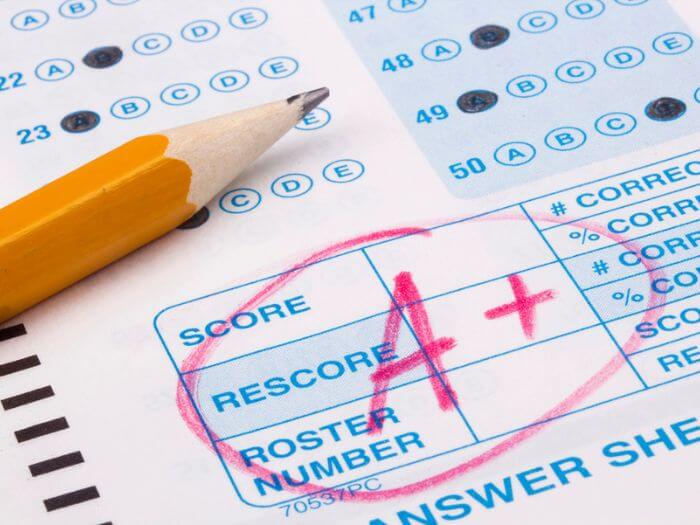The TOEFL and IELTS exams are two of the most popular English language exams.
Millions of candidates take these tests every year because they might need to prove their English proficiency for work, study, or immigration.
Both tests are recognized by thousands of institutions around the world, but they’re designed differently. They have different formats, scoring systems, assessment focuses, and costs.
Which exam should you take?
In this toefl vs ielts detailed comparison, I’ll tell you everything you need to know about the TOEFL and IELTS tests so that you choose the right one for you.
It’s going to be a long article, so here’s a table of contents, so you can easily find what you’re most interested in.
Table of Contents
What Are the TOEFL and IELTS Exams?

Let’s take a quick look at both exams so you can have a general overview of what they are.
TOEFL
The TOEFL (Test of English as a Foreign Language) is an English language exam developed in the US by Educational Testing Service (ETS), a private educational testing and assessment organization.
The TOEFL official website says the exam is accepted by more than 13,000 universities and other institutions in over 160 countries around the world.
It focuses on academic English and it’s generally the ideal test for you if you’re planning to study in the US or Canada.
IELTS
The IELTS (International English Language Testing System) is managed by three institutions: the British Council, IDP: IELTS Australia, and Cambridge Assessment English.
There are two versions of the IELTS test: IELTS Academic and IELTS General Training.
The IELTS Academic test is for those who want to study in an English-speaking environment (usually not the US), while the IELTS General Training test is for people who want to work or move to an English-speaking country, especially the UK, Canada, Australia, and New Zealand.
Let’s have a look at the key differences between these exams.
IELTS vs TOEFL Difference
So what's the difference between IELTS and TOEFL? The main differences between the two exams are about:
- The test format
- The scoring system
- The test acceptance and recognition
- Costs
The table below summarises the key differences for you.
| TOEFL | IELTS | |
| Administering Organizations | Educational Testing Service (ETS), U.S. | British Council, IDP: IELTS Australia, and Cambridge Assessment English |
| Primary Focus | Academic English | Academic and General Training (for study, work, and immigration purposes) |
| Versions Available | Single version | Academic and General Training |
| Test Format | Computer-based (iBT) | Paper-based and computer-based formats available |
| Sections | Reading, Listening, Speaking, Writing | Reading, Listening, Speaking, Writing |
| Total Test Duration | Approximately 2 hours | 2 hours and 45 minutes |
| Reading Section | 2 passages (approx. 700 words each) with 20 questions; academic-focused texts | 3 long texts with 40 questions; academic texts for Academic version, general texts for General Training |
| Listening Section | 3 lectures and 2 conversations; campus-related language and various accents | 4 recordings; everyday social, educational, and academic contexts |
| Speaking Section | 4 tasks; responses are recorded via microphone | 3 parts; face-to-face interview with an examiner |
| Writing Section | Integrated task (reading + listening, then writing) and academic discussion task | Task 1: Describe data or process (Academic) or write a letter (General); Task 2: Academic essay |
| Scoring System | 0-120 total score, with 30 points per section | 0-9 band scale for each section, averaged to produce an overall band score |
| Acceptance Regions | Widely accepted in the U.S. and Canada | Widely accepted in the UK, Australia, Canada, New Zealand, and for immigration in these countries |
| Cost | $180 to $250 (varies by location) | $200 to $250 (varies by location) |
Let’s talk about these differences in more detail.
TOEFL Format: Overview

Both TOEFL and IELTS assess the four skills (reading, writing, speaking, and listening), but the tests are structured differently.
The whole TOEFL exam takes just under 2 hours to complete. Here’s a table taken from the TOEFL official website that shows you all the test sections.
| Section | Estimated Timing | Questions/Tasks | Description |
| Reading | 35 minutes | 20 questions | Read passages and respond to questions. |
| Listening | 36 minutes | 28 questions | Answer questions about brief lectures or classroom discussions. |
| Speaking | 16 minutes | 4 tasks | Talk about a familiar topic and discuss material you read and heard. |
| Writing | 29 minutes | 2 tasks | Read a passage, listen to a recording, type your response. State and support an opinion in an online classroom discussion. |
Let’s explore each section.
TOEFL Format: Reading
Assessment Focus: your ability to read and understand academic texts. You’ll be assessed on how well you can:
- recognize information directly stated in the text;
- recognize information that is implied, or why an author wrote something;
- know the meaning of general academic words and phrases;
- select a shorter sentence that has the same meaning as the original sentence;
- place a sentence in a paragraph where it makes the most sense;
- select three statements that best describe the main ideas in the reading passage;
Reading Tasks: 2 passages, each around 700 words in length, with 10 questions for each passage.
Extra Info: the reading passages are taken from university-level textbooks and cover a range of academic subjects.
Test Time: 35 minutes.
TOEFL Format: Listening
Assessment Focus: your ability to understand conversations and lectures in English. You’ll be assessed on how well you can:
- identify the main point or purpose of the conversation or lecture;
- identify specific facts from the conversation or lecture;
- understand why a speaker said something;
- recognise how a speaker feels about something;
- understand why the lecture is structured the way it is;
- predict an outcome, draw a conclusion or understand a cause-and-effect relationship;
- recognise information that is implied but not directly stated.
Listening Tasks:
- 3 lectures (3-5 minutes each, some with classroom discussion) with 6 questions per lecture)
- 2 conversations (3 minutes each) with 5 questions per conversation
Extra Info: the audio texts use language commonly heard on university campuses and include native-speaker English accents from North America, the U.K., New Zealand or Australia. You can take notes during the test to help answer questions.
Test Time: approximately 36 minutes.
TOEFL Format: Speaking

Assessment Focus: your ability to communicate effectively in academic contexts. You’ll be assessed on how well you can:
- express and support your preference between two options;
- show your understanding of a campus-related topic;
- show your understanding of an academic topic.
Speaking Tasks:
- Independent Speaking Task (Question 1): you’ll have to speak about personal ideas, opinions, and experiences.
- Integrated Speaking Tasks (Questions 2–4): you’ll have to combine skills (listening and speaking, or listening, reading, and speaking) like you would in real life inside and outside the classroom.
Your responses will need to be 45 or 60 seconds long.
Extra Info:
- Your responses will be recorded using a microphone.
- You’ll be given 5–30 seconds to prepare what you’d like to say.
- Your speaking will be scored using a mix of AI and certified human raters.
Test Time: approximately 16 minutes.
TOEFL Format: Writing
Assessment Focus: your ability to write in clear, organised English in academic contexts. You’ll be assessed on how well you can:
- read a passage, listen to a lecture, and then write a response comparing them.
- share your opinion in an online discussion with a professor and other students.
Writing Tasks:
- Integrated Writing Task (20 minutes): read a passage, listen to a lecture, then write a response.
- Writing for an Academic Discussion Task (10 minutes): express and support an opinion in an online classroom setting.
Extra Info:
- You’ll type your responses on a computer keyboard.
- You don't need deep knowledge of a specific topic to get a high score.
- The scoring system is the same as the speaking section.
Test Time: approximately 29 minutes.
Let’s now have a look at the format of the IELTS exam.
IELTS Format: Overview

Both the IELTS Academic and the IELTS General Training tests are 2 hours and 45 minutes long and have 4 sections: Listening, Reading, Writing, and Speaking.
The Listening, Reading, and Writing sections take place on the same day with no breaks in between. The Speaking section may be scheduled on the same day or up to 7 days before or after the other sections.
Here’s a table taken from Cambridge Assessment English (one of the 3 institutions that offer the exam) that shows you all the test sections.
| Paper | Content | Time |
| Listening | 40 questions | Approximately 30 minutes (plus 10 minutes’ transfer time for the paper-based test) |
| Reading | 40 questions | 60 minutes |
| Writing | 2 tasks | 60 minutes |
| Speaking | 3 parts | 11–14 minutes |
The Speaking and Listening sections are the same for both the IELTS Academic and IELTS General Training tests, but the Reading and Writing sections are different.
Let’s start with IELTS Listening and IELTS Speaking.
Academic / General Training IELTS Format: Listening
Assessment Focus: your ability to:
- understand main ideas;
- understand specific factual information;
- recognise the opinions, attitudes, and purpose of a speaker;
- follow the development of an argument.
Listening Tasks: you’ll have to answer a total of 40 questions about 4 recordings of native English speakers that have a variety of accents.
- Recording 1: a conversation between two people set in an everyday social context.
- Recording 2: a monologue set in an everyday social context
- Recording 3: a conversation between up to four people set in an educational or training context, e.g. a university tutor and a student discussing an assignment.
- Recording 4: a monologue on an academic subject, e.g. a university lecture.
There are different types of questions:
- multiple choice
- matching
- plan/map/diagram labelling
- form/note/table/flow-chart/summary completion
- sentence completion
Extra Info:
- Each answer is worth 1 mark and you won't be penalised if you leave an answer blank.
- You can only listen to the recordings once.
- You’ll be given ten minutes at the end of the test to transfer your answers to an answer sheet.
Test Time: 30 minutes (+10 minutes at the end to transfer your answers onto an answer sheet)

Academic / General Training IELTS Format: Speaking
Assessment Focus: your ability to:
- communicate, express and justify your opinions on everyday topics and common experiences;
- speak at length on a given topic using appropriate language;
- organise your ideas coherently;
- analyse, discuss, and speculate about issues.
Speaking Tasks: the Speaking Test is a face-to-face interview with a speaking examiner and it’s divided into 3 sections: IELTS Speaking Part 1, IELTS Speaking Part 2, and IELTS Speaking Part 3.
- Part 1: You’ll answer general questions on familiar topics, e.g. home, family, work, studies and interests.
- Part 2: You’ll be given a task card which asks you to talk about a particular topic. You’ll have one minute to prepare and make notes and then be asked to talk for 1-2 minutes on the topic.
- Part 3: You’ll answer further questions connected to the topic of Part 2. These questions are designed to allow you to discuss more abstract issues and ideas.
Extra Info:
- You will be marked on the four criteria: fluency and coherence, lexical resource, grammatical range and accuracy, and pronunciation.
- You can find the official assessment criteria here.
- I wrote a full blog post on the IELTS Speaking Test to help you get the score you need – IELTS Speaking Questions
Test Time: Between 11 to 14 minutes

As I told you before, the Reading and Writing sections of the IELTS Academic and the IELTS General Training tests are different.
Let’s look at the IELTS Academic first.
IELTS Academic Format: Reading
Assessment Focus: your ability to understand arguments, identify opinions and purposes, and grasp main ideas, details, and implied meanings.
Reading Tasks: 3 long texts from sources like books, journals, English magazines, and newspapers. The texts cover topics relevant to university studies or professional English.
There are a total of 40 questions of different types:
- Identifying writer’s views/claims (Yes/No/Not given)
- Identifying information (True/False/Not given)
- Multiple choice
- Matching information
- Matching headings
- Matching features
- Matching sentence endings
- Sentence completion
- Summary/note/table/flow chart completion
- Diagram label completion
- Short-answer questions
Extra Info:
- Each correct answer receives 1 mark.
- Your final score is given as a band score from 1–9 in whole or half bands, e.g. 4 or 6.5.
Test Time: 60 minutes
IELTS Academic Format: Writing
Assessment Focus: a wide range of writing skills, including how well you:
- write an appropriate response to a task question appropriately
- organise your ideas
- use a range of vocabulary and grammar accurately
Writing Tasks:
There are 2 questions: IELTS Writing Task 1 and IELTS Writing Task 2.
IELTS Writing Task 1
You’ll be given a graph, table, chart or diagram and asked to describe, summarise or explain the information in your own words. You might need to describe data, the stages of a process, or how something works. Task 1 is worth half as much as Task 2, and you should write at least 150 words.
IELTS Writing Task 2
You’ll be asked to write an academic essay (minimum 250 words) in response to a point of view, argument or problem.
Extra info
- You should spend no more than 20 minutes on IELTS Writing Task 1 and 40 minutes on IELTS Writing Task 2.
- Your writing will be marked by a certificated IELTS examiner.
- You should write in an academic or semi-formal/neutral style.
- You’ll have 1 hour to complete both tasks, so you should manage your time efficiently!
- You can find the IELTS Writing official assessment criteria here.
Test Time: 60 minutes

IELTS General Training Format: Reading
Assessment Focus: your ability to:
- understand specific and main points of a text;
- recognise specific information given in the text;
- recognise opinions, theories, and ideas;
- scan a text in order to find specific information (specific details, examples, reasons, descriptions, comparisons, summaries or explanations);
- identify the general topic of a paragraph;
- recognise relationships and connections between facts in the text
- skim and scan the text to find information quickly;
- understand a detailed description in the text;
- relate descriptions to the information given in a diagram.
Reading Tasks: there are 40 questions divided into 3 sections: social survivor, workplace survival, and general reading.
- Section 1 (social survival): this may contain two or three short texts or several shorter texts that are relevant to basic linguistic survival in English such as notices, advertisements, college brochures and accommodation lists.
- Section 2 (workplace survival): this focuses on the workplace context. Texts might include job descriptions, contracts, work policies, manuals, staff development and training materials.
- Section 3 (general reading) contains one longer and more complex text of general interest. You may get an article from a newspaper or magazine, a book extract, or a text taken from the internet. The texts can be about a variety of topics.
The question types are the same as the IELTS Academic Reading test (multiple choice, sentence completion, etc.)
Extra Info:
- Each answer is worth 1 mark and you won't be penalised if you leave an answer blank.
Test Time: 60 minutes
IELTS General Training Format: Writing
Assessment Focus: a wide range of writing skills, including how well you:
- write an appropriate response to a task question appropriately
- organise your ideas
- use a range of vocabulary and grammar accurately
Writing Tasks:
2 questions: IELTS Writing Task 1 and IELTS Writing Task 2.
IELTS Writing Task 1: Letter Writing
You will be presented with a situation and asked to write a letter requesting information, or explaining the situation.
For example, you may be asked to write to a college accommodation officer about problems with your accommodation or to a new employer about problems you are having with managing your time.
Depending on the task, the letter might be personal, semi-formal or formal in style. You should write at least 150 words and spend no more than 20 minutes on this task.
IELTS Writing Task 2
This is the same as IELTS Academic Writing Task 2: an academic essay (minimum 250 words) in response to a point of view, argument or problem.
Extra info
- Your writing will be marked by a certificated IELTS examiner.
- You can find the IELTS Writing official assessment criteria here.
Test Time: 60 minutes

IELTS vs TOEFL Scores
The scoring systems for TOEFL and IELTS are very different.
TOEFL Scoring
Each section of the exam is scored out of 30 points. Given that there are 4 sections, the total score will be between 0 and 120.
Here’s a table taken from the TOEFL official website that shows you the different scoring levels.
| Skill | Level |
| Reading | Advanced (24–30) High-Intermediate (18–23) Low-Intermediate (4–17) Below Low-Intermediate (0–3) |
| Listening | Advanced (22–30) High-Intermediate (17–21) Low-Intermediate (9–16) Below Low-Intermediate (0–8) |
| Speaking | Advanced (25–30) High-Intermediate (20–24) Low-Intermediate (16–19) Basic (10–15) Below Basic (0–9) |
| Writing | Advanced (24–30) High-Intermediate (17–23) Low-Intermediate (13–16) Basic (7–12) Below Basic (0–6) |
You can read the TOEFL official scoring descriptors here.
IELTS Scoring
IELTS (both the Academic and General Training versions) uses a band score system that ranges from 0 to 9 for each section. The four scores are averaged to produce an overall band score.
Here’s the 0-9 scale:
- Band 9 (expert user): Full operational command of the language.
- Band 8 (very good user): Fully operational command with only occasional unsystematic inaccuracies.
- Band 7 (good user): Operational command of the language, with occasional errors.
- Band 6 (competent user): Generally effective command despite some inaccuracies.
- Band 5 (modest user): Partial command of the language, coping with overall meaning in most situations.
- Band 4 (limited user): Basic competence limited to familiar situations.
- Band 3 (extremely limited user): Conveys and understands only general meaning in very familiar situations.
- Band 2 (intermittent user): No real communication is possible except for the most basic information.
- Band 1 (non-user): Essentially no ability to use the language.
- Band 0: Did not attempt the test.
You could also get “half scores” (e.g., 6.5 or 7.5).
TOEFL vs IELTS: Who Accepts These Tests?
Both TOEFL and IELTS are accepted around the world, but certain regions and institutions may have a preference for one over the other.
TOEFL
TOEFL is usually the go-to test for people looking to study in the USA. This is not surprising given that the exam’s main focus is on academic English. Other countries may prefer TOEFL for immigration purposes, but it’s less commonly required for this purpose than IELTS.
You can check which institutions accept TOEFL scores here.
IELTS
IELTS is widely recognized in the UK, Australia, Canada, and New Zealand, and is the test of choice for immigration to these countries. Most European and Asian institutions also accept IELTS scores.

TOEFL vs IELTS: How Much Do They Cost?
The TOEFL typically costs between $180 and $250 depending on your location.
IELTS fees are similar – around $200 to $250.
IELTS, however, offers both paper and computer versions, while TOEFL is mainly a computer-based test.
FAQs About TOEFL vs IELTS
Is TOEFL easier than IELTS?
Whether the TOEFL is easier than the IELTS depends on a few factors, especially your comfort with different test formats and your personal strengths in English.
Here are some differences to consider:
Test Format:
TOEFL is computer-based, with all sections conducted online, including speaking (recorded on a microphone).
IELTS offers both paper-based and computer-based options, and the speaking section is an in-person interview.
Content and Structure:
TOEFL focuses more on academic English, with passages and listening excerpts similar to university-level content.
IELTS covers both academic and everyday English, making it slightly more accessible if you’re comfortable with conversational English.
Accents:
TOEFL primarily uses American accents in the listening section.
IELTS features various accents, including British, Australian, and North American, which can be challenging for some test-takers.
Writing and Speaking:
TOEFL writing tends to focus on essay responses, while IELTS includes both an essay and a more practical writing task (like describing data in a graph).
IELTS speaking is conversational, which some find easier than TOEFL’s recorded, structured responses.
In summary: IELTS may be slightly easier for those who prefer a conversational approach and a mix of academic and real-life English, while TOEFL may suit those who are comfortable with American English and academic content. Ultimately, “easier” depends on your comfort level with each format.
Is TOEFL or IELTS more accepted?
Both TOEFL and IELTS are widely accepted by universities, immigration authorities, and employers around the world, but their popularity can vary by region and institution:
North America: TOEFL is generally more common in the United States and Canada, though most universities in these countries now accept both TOEFL and IELTS. TOEFL is sometimes preferred by American institutions as it focuses on American English.
United Kingdom, Australia, and Europe: IELTS tends to be more widely accepted in the UK, Australia, and European countries. IELTS is also the primary test for UK, Australian, New Zealand, and Canadian immigration applications.
Asia and Worldwide: Both exams are accepted by thousands of institutions worldwide. Some Asian countries may have a slight preference for IELTS due to its strong focus on British and Australian English, but TOEFL is also widely recognised.
Immigration: For immigration purposes, IELTS is typically more accepted, especially in the UK, Canada, Australia, and New Zealand.
In summary: Both tests are broadly accepted for academic and professional purposes, but if you're targeting specific countries (like the U.S. for TOEFL or the UK for IELTS) or immigration needs, you may want to choose accordingly.
Which certificate is better, TOEFL or IELTS?
Whether TOEFL or IELTS is “better” depends on your goals, destination, and test-taking style, as both are highly respected English proficiency tests.
Here are some factors to help you decide:
Destination Requirements:
TOEFL is traditionally more favoured by universities in the United States and Canada, although most institutions now accept both.
IELTS is generally preferred for universities and immigration purposes in the UK, Australia, New Zealand, and Canada.
Test Format:
TOEFL is fully computer-based, with speaking responses recorded.
IELTS offers both paper and computer options, and speaking is done in a face-to-face interview, which some test-takers find more natural.
Academic vs. General Content:
TOEFL leans towards academic English with passages and listening sections that reflect university settings, making it ideal for students preparing for higher education.
IELTS has both an Academic and General Training version. The General Training test focuses on everyday English, which can be beneficial for immigration or general employment.
Regional Preferences:
For study in North America, TOEFL might be slightly more recognised.
For UK, Australian, and Canadian immigration, IELTS is often required or preferred.
In summary: Neither is universally “better”; your choice should align with the preferences of your destination country or institution, and your comfort with each test's format. Both certificates are valuable and globally recognised.
What is IELTS 7 equal to TOEFL?
An IELTS score of 7 is generally considered equivalent to a TOEFL iBT score of 94-101.
Here’s a basic comparison of scoring ranges to give you an idea:
IELTS 7.0 is equivalent to TOEFL 94-101.
IELTS 6.5 is roughly equal to TOEFL 79-93.
IELTS 8.0 corresponds to TOEFL 110-114.
Many institutions provide their own conversion tables, so it’s always best to check with the specific institution if you have a target score in mind.
Generally, an IELTS 7.0 and TOEFL 94-101 indicate a similar level of English proficiency, showing strong comprehension and communication skills.
Which Test Is Best For You? (Some Final Thoughts)

Here are some tips and considerations if you're still deciding between IELTS or TOEFL:
- If you’re planning to study in the US, TOEFL might be the best choice.
- For immigrating to or studying in the UK, Australia, or New Zealand, IELTS is often preferred by many people.
- Which exam does your country of destination prefer? Go to the website of the immigration service and find out! Then decide based on that. The same goes for the university you’re applying to. Some may prefer TOEFL, others IELTS. Some institutions may prefer either one. Check their website!
Thanks for reading this guide. I hope it was useful! Whichever exam you’ll take, be sure you’ll prepare for it! Don’t make the mistake of thinking you need no preparation.
I’ve seen many students (who had very good English) fail the exam and waste money because they didn’t prepare enough.
Don’t be one of them!
Good luck!

Olly Richards
Creator of the StoryLearning® Method
Olly Richards is a renowned polyglot and language learning expert with over 15 years of experience teaching millions through his innovative StoryLearning® method. He is the creator of StoryLearning, one of the world's largest language learning blogs with 500,000+ monthly readers.
Olly has authored 30+ language learning books and courses, including the bestselling "Short Stories" series published by Teach Yourself.
When not developing new teaching methods, Richards practices what he preaches—he speaks 8 languages fluently and continues learning new ones through his own methodology.










































